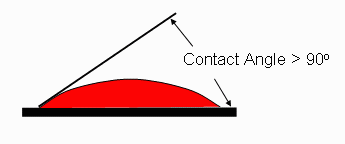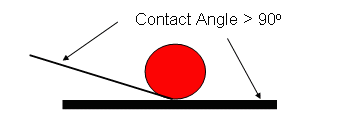Modeling Subsurface Petroleum Hydrocarbon Transport
| Module Home Objectives Table of Contents Previous < Next > |
| 4 of 22 |

|
Because of the stronger force of attraction for the solid surface, the wetting phase spreads across the surface. |

|
A non-wetting phase is repelled from the surface, so that it's contact with the surface is minimized. Thus, the non-wetting phase "beads up" on the surface. |
|
These schematics show the concept behind a contact angle measurement. The contact angle is used to characterize wetting behavior and is idealized because the measurement is made on an extremely smooth flat plate. The plate is made from the material that is the most prevalent component of the porous medium (i.e., quartz). |
|

|
The contact angle is measured through the wetting phase and as illustrated below, a fluid is said to wet the surface if the contact angle is less than 90 degrees. The fluid is strongly wetting if the contact angle is 0o or nearly zero. |

|
If the contact angle is greater than 90 degrees, the fluid is said to be non-wetting. |
Home | Glossary | Notation | Links | References | Calculators |
|
